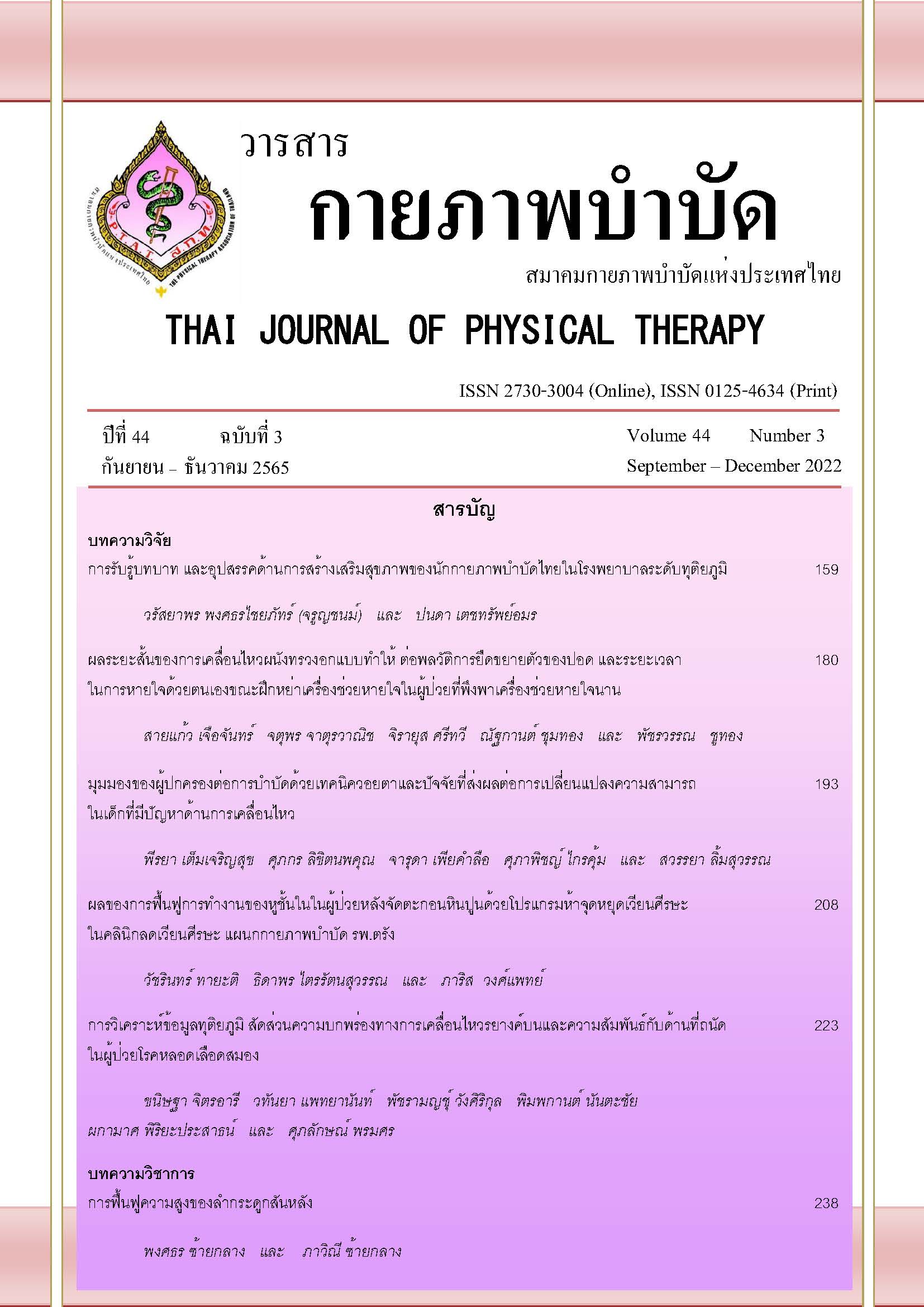The effect of five points hand free program for benign paroxysmal positional vertigo patients after canalith repositioning procedure in vestibular rehabilitation clinic, physical therapy division, Trang hospitalThe Effect of Five Points Hand Free (FPF) program in BPPV patients after Canalith Repositioning Procedure in Vestibular Rehabilitation Clinic, Physiotherapy Department, Trang Hospital
Main Article Content
Abstract
Background: Modified Cawthorne Cooksey exercise was the standard therapy for vestibular rehabilitation (VR) after canalith repositioning of patients with benign paroxysmal positional vertigo (BPPV) at Trang Hospital. This form of exercise requires use of arm function which can be difficult or painful in some patients. A new five points hands free (FPHP) exercise was invented as an alternative.
Objective: To compare the effectiveness of VR using FPHF versus MCC exercises by means of customized vestibular rehabilitation (CVR).
Methods: Retrospective analysis comparing the improvement of BPPV patients who use FPHF or CVR for their VR. Dizziness severities were assessed with the visual analogue scale (VAS). Gaze stability was assessed with the gaze-evoked nystagmus test (GEN) and head impulse test (HIT).
Results: Both FPHF and CVR groups showed statistically significant improvement of VAS, HIT, and GEN after VR at p<0.01 between before and after VR exercises. However, the FPHF groups showed significantly greater improvement in GEN score than the CVR group with p <0.01.
Conclusion: This retrospective study demonstrated that both FPHF and CVR are effective for VR. The FPHF may be more effective than the CVR to improve gaze stability.
Article Details

This work is licensed under a Creative Commons Attribution-NonCommercial-NoDerivatives 4.0 International License.
References
Hülse R, Biesdorf A, Hörmann K, Stuck B, Erhart M, Hülse M, et al. Peripheral vestibular disorders: An epidemiologic survey in 70 million individuals: An epidemiologic survey in 70 million individuals. Otol Neurotol. 2019;40(1):88–95.
Tungvachirakul V, Lisnichuk H, O’Leary SJ. Epidemiology of vestibular vertigo in a neuro-otology clinic population in Thailand. J Laryngol Otol. 2014;128 Suppl 2(S2):S31-8.
Yetiser S. Review of the pathology underlying benign paroxysmal positional vertigo. J Int Med Res. 2020;48(4):300060519892370.
Giommetti G, Lapenna R, Panichi R, Mobaraki PD, Longari F, Ricci G, et al. Residual Dizziness after Successful Repositioning Maneuver for Idiopathic Benign Paroxysmal Positional Vertigo: A Review. Audiol Res. 2017;7(1):178.
Hall CD, Herdman SJ, Whitney SL, Cass SP, Clendaniel RA, Fife TD, et al. Vestibular Rehabilitation for Peripheral Vestibular Hypofunction: An Evidence-Based Clinical Practice Guideline: from the American physical therapy association neurology section. J Neurol Phys Ther. 2016;40(2):124-55.
Kulcu DG, Yanik B, Boynukalin S, Kurtais Y. Efficacy of a home-based exercise program on benign paroxysmal positional vertigo compared with betahistine. J Otolaryngol Head Neck Surg. 2008;37(3):373–9.
Hall CD, Heusel-Gillig L, Tusa RJ, Herdman SJ. Efficacy of gaze stability exercises in older adults with dizziness. J Neurol Phys Ther. 2010;34(2):64–9.
Meldrum D, Burrows L, Cakrt O, Kerkeni H, Lopez C, Tjernstrom F, et al. Vestibular rehabilitation in Europe: a survey of clinical and research practice. J Neurol. 2020;267(Suppl 1):24–35.
Toupet M, Ferrary E, Grayeli AB. Visual analog scale to assess vertigo and dizziness after repositioning maneuvers for benign paroxysmal positional vertigo. J Vestib Res. 2011;21(4):235-41.
Strupp M, Hüfner K, Sandmann R, Zwergal A, Dieterich M, Jahn K, et al. Central oculomotor disturbances and nystagmus: a window into the brainstem and cerebellum. Dtsch Arztebl Int. 2011;108(12):197–204.
Giommetti G, Lapenna R, Panichi R, Mobaraki PD, Longari F, Ricci G, et al. Residual dizziness after successful repositioning maneuver for idiopathic benign paroxysmal positional vertigo: A review. Audiol Res. 2017;7(1):178.
Whyte CA, Petrock AM, Rosenberg M. Occurrence of physiologic gaze-evoked nystagmus at small angles of gaze. Invest Ophthalmol Vis Sci. 2010;51(5):2476–8.
Schubert MC, Tusa RJ, Grine LE, Herdman SJ. Optimizing the sensitivity of the head thrust test for identifying vestibular hypofunction. Phys Ther. 2004;84(2):151-8.
Verrecchia L, Galle Barrett K, Karltorp E. The feasibility, validity and reliability of a child friendly vestibular assessment in infants and children candidates to cochlear implant. Int J Pediatr Otorhinolaryngol. 2020;135
Bunasuwan P. Vertigo Available from: http://www.med.tu.ac.th/UserFiles/File/ENT/sheet%20vertigo.pdf [cited 12 Sep 2021].
Herdman SJ, Clendaniel R. Vestibular Rehabilitation 4e. 4th ed. Philadelphia, PA: F.A. Davis Company; 2014.
Hegemann S, Straumann D, Bockisch C. Alexander’s law in patients with acute vestibular tone asymmetry--evidence for multiple horizontal neural integrators. J Assoc Res Otolaryngol. 2007;8(4):551–61
Tarnutzer AA, Dieterich M. Bedside examination of the vestibular and ocular motor system in patients with acute vertigo or dizziness. Clin Transl Neurosci. 2019;3(2): 2514183X1988615.
Whitney SL, Wrisley DM, Marchetti GF, Furman JM. The effect of age on vestibular rehabilitation outcomes. Laryngoscope. 2002; 112(10):1785–90.
Herdman SJ, Schubert MC, Das VE, Tusa RJ. Recovery of dynamic visual acuity in unilateral vestibular hypofunction. Arch Otolaryngol Head Neck Surg. 2003;129(8):819-24.
Mahfuz MM, Schubert MC, Figtree WVC, Migliaccio AA. Retinal Image Slip Must Pass the Threshold for Human Vestibulo-Ocular Reflex Adaptation. J Assoc Res Otolaryngol. 2020;21(3):277-85.
Herdman SJ. Role of vestibular adaptation in vestibular rehabilitation. Otolaryngol Head Neck Surg. 1998;119(1):49-54.
Somisetty S, M Das J. Neuroanatomy, Vestibulo-ocular Reflex. In: StatPearls. Treasure Island (FL): StatPearls Publishing; 2021.
Bjasch D, Bockisch CJ, Straumann D, Tarnutzer AA. Differential effects of visual feedback on subjective visual vertical accuracy and precision. PLoS One. 2012; 7(11):e49311.
Chen P-Y, Hsieh W-L, Wei S-H, Kao C-L. Interactive wiimote gaze stabilization exercise training system for patients with vestibular hypofunction. J Neuroeng Rehabil. 2012;9(1): 77.
Dhote SB, Bele AW. A protocol on effect of gaze exercises and balance regimen on quality of life of patients with peripheral-vertigo. Indian J Forensic Med Toxicol. 2021;15(2): 753–6.
Schubert MC, Zee DS. Saccade and vestibular ocular motor adaptation. Restor Neurol Neurosci. 2010;28(1):9–18.
Teggi R, Quaglieri S, Gatti O, Benazzo M, Bussi M. Residual dizziness after successful repositioning maneuvers for idiopathic benign paroxysmal positional vertigo. ORL J Otorhinolaryngol Relat Spec. 2013;75(2):74–81.

